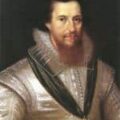On this day in history, 8th November 1605, Robert Catesby, the man thought to have been responsible for hatching up the Gunpowder Plot, was shot dead at Holbeche House in Staffordshire. Although he was initially buried near Holbeche, his body was exhumed so that he could be decapitated and his head hung on the side of Parliament House as a warning to other would-be traitors.
Robert Catesby was the son of Sir William Catesby and Anne Throckmorton (of the Throckmortons of Coughton, Warwickshire). Catesby was a Catholic and he had been in trouble during the reign of Elizabeth I for being involved in the Essex Rebellion, a rebellion instigated by Robert Devereux, Earl of Essex. He was imprisoned and fined 4,000 marks as punishment.
Catesby and other Catholics hoped that the accession of James I would bring an end to the oppression and persecution of Catholics, but they were disappointed. In her book, “The Gunpowder Plot”, historian and author Lady Antonia Fraser wrote of Catesby’s mentality as being “that of the crusader who does not hesitate to employ the sword in the cause of values which he considers are spiritual” and Catesby does not seem to have had any qualms in plotting to bring down James I and his government by blowing up the Palace of Westminster (the Houses of Parliament) on the opening session of Parliament. Unfortunately for Catesby and his fellow conspirators, the English government received a tip-off and on the night of the 4th/5th November 1605 the cellars beneath Westminster were searched and Guy Fawkes was found with 36 barrels of gunpowder.
The plot had been foiled, Fawkes had been arrested and tortured, but Catesby did not give up. On the 6th November he and his friends raided Warwick Castle for supplies and he sent a message to Coughton Court asking Father Henry Garnet, a Jesuit, and his priests to help him raise an army in Wales. Garnet did not want to be involved and so fled. Catesby made his way to Huddington Court in Worcestershire, the home of his cousin, Thomas Wintour, where, on the morning of the 7th November, he and his fellow conspirators went to confession and then took the sacrament. They travelled to Hewell Grange, Worcestershire, home of the absent Thomas Windsor, which they ransacked for arms and money, and then on to Holbeche House, Staffordshire, where they attempted to dry out some gunpowder by spreading it in front of the fire. Some of the gunpowder caught fire, injuring Catesby, Ambrose Rookwood and John Grant. Grant was so badly injured that his eyes were burnt out, but although some of the conspirators fled after the fire, he remained at Holbeche along with Catesby, Thomas Wintour, who had rejoined the group, John and Christopher Wright, Rookwood and Thomas Percy to await the arrival of James I’s men.
At 11am on the 8th November 1605, 200 of the King’s men, led by the Sheriff of Worcester, Richard Walsh, besieged the house. It is said that Catesby kissed his gold crucifix, which he wore around his neck, and vowed that he would not be taken prisoner but that he would defend himself with his sword. Catesby was shot but managed to crawl into the house, where he was later found dead but clutching a picture of the Virgin Mary.
Thomas Wintour survived a shot to the shoulder but was executed along with his fellow conspirators, Rookwood, Robert Keyes and Guy Fawkes, on the 31st January 1606 by being hanged, drawn and quartered. His brother, Robert, was executed in the same manner on the previous day, 30th January, along with John Grant, Thomas Bates and Sir Everard Digby. Thomas Percy was shot by the same musketball which killed Catesby and he, like Catesby, was exhumed and his head displayed outside Parliament. The Wright brothers were shot dead at Holbeche.
Robert Catesby had spoken of how he had given everything for “the honour of the cross” and he would have seen his death as that of a martyr for the Catholic faith. It is strange that many people have never heard of Catesby, the man who planned the Gunpowder Plot, but, instead, we remember Guy Fawkes, the man in charge of the gunpowder. How odd!
Notes and Sources
- Faith and Treason: The Story of the Gunpowder Plot, Antonia Fraser
- Wikipedia page on Robert Catesby
- The Gunpowder Plot, Elizabeth Files article








